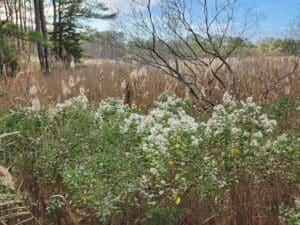Groundsel: A Highly-Tolerant Fall-Blooming Native
By Su Fiske, Inland Bays Garden Center | Special to the Coastal Point Nov 17, 2022

Also called sea-myrtle, consumption weed, eastern baccharis, salt marsh-elder and salt bush, native groundsel is found all over this area, and I love that it is fall-blooming, with densely clustered white flowers.
Groundsel (Baccharis halimifolia L.) is the largest member of the aster family and grows between 6 and 10 feet in height, with beautiful greenish-gray leaves. The females have these wondrous feathery seeds that are floating through the air in the fall.
Since you can find it all over Assateague, you know that it is tolerant of salt spray and brackish water. Groundsel does like the wet, with part shade or full sun. It can handle much of the soil in this area. The plants have an extensive root system and can be grown on sand or thin coastal soils to help bind the soil.
Groundsel is a dioecious plant, which means female and male flowers bloom on different shrubs. In this area, it usually stays green during warmer winters.
This plant is a great choice for along the edges of ponds, retention basins, rain gardens, seaside garden and areas with saline conditions. You can prune groundsel into a hedge or train it into a single-stem tree.
Wildlife benefits: Groundsel’s density provides nesting habitat and cover for birds and other animals. It also attracts bees, butterflies, moths and seed-eating birds.
Fun facts:
• A female plant in one season can have 10,000 and between 450,000 to 900,000 seeds, with one report as high as 1.5 million.
• Baccharis is for the god of wine.
• Groundsel is considered invasive in Australia, as it was introduced there as an ornamental in the late 1800s to early 1900s.
• In southern Louisiana, it has been used as a medicine to treat inflamed kidneys and fever. It clears viral and bacterial infections. Native Americans first discovered the medicinal properties of this plant in the 1800s. Creole and Cajun communities used it before the onset of drug prescriptions and antibiotics.
“Described as ‘a horrible-tasting tea reputed to cure almost anything,’ groundsel bush showed some of the most potent activity in the Boudreau et al. antidiabetic study,” according to Claudia S. Copeland, PhD. “Traditionally, it was used to treat diabetes, inflamed kidneys, congestion, fever and other flu-like symptoms. Though it is not well-known outside of Louisiana, this was one of the most highly regarded medicinal plants among Native American, Cajun, and Creole healers.”
• Its presence is said to indicate oil beneath the soil.
